用SPSS进行非线性回归分析实例
2010-12-18 MedSci原创 MedSci原创
非线性回归分析 在回归分析中,当自变量和因变量间的关系不能简单地表示为线性方程,或者不能表示为可化为线性方程的时侯,可采用非线性估计来建立回归模型。 SPSS提供了非线性回归“Nonlinear”过程,下面就以实例来介绍非线性拟合“Nonlinear”过程的基本步骤和使用方法。 应用实例 研究了南美斑潜蝇幼虫在不同温度条件下的发育速率,得到试验数据如下: 表5-1 南美斑潜蝇幼虫在不同
非线性回归分析
在回归分析中,当自变量和因变量间的关系不能简单地表示为线性方程,或者不能表示为可化为线性方程的时侯,可采用非线性估计来建立回归模型。
SPSS提供了非线性回归“Nonlinear”过程,下面就以实例来介绍非线性拟合“Nonlinear”过程的基本步骤和使用方法。
应用实例
研究了南美斑潜蝇幼虫在不同温度条件下的发育速率,得到试验数据如下:
表5-1 南美斑潜蝇幼虫在不同温度条件下的发育速率
|
温度℃ |
17.5 |
20 |
22.5 |
25 |
27.5 |
30 |
35 |
|
发育速率 |
0.0638 |
0.0826 |
0.1100 |
0.1327 |
0.1667 |
0.1859 |
0.1572 |
根据以上数据拟合逻辑斯蒂模型:

本例子数据保存在DATA6-4.SAV。
1)准备分析数据
在SPSS数据编辑窗口建立变量“t”和“v”两个变量,把表6-14中的数据分别输入“温度”和“发育速率”对应的变量中。
或者打开已经存在的数据文件(DATA6-4.SAV)。
2)启动线性回归过程
单击SPSS主菜单的“Analyze”下的“Regression”中“Nonlinear”项,将打开如图5-1所示的线回归对话窗口。
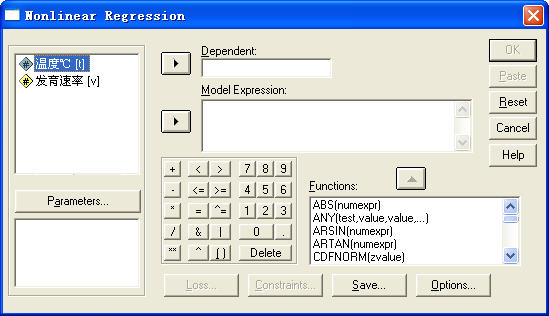
图5-1 Nonlinear非线性回归对话窗口
3) 设置分析变量
设置因变量:从左侧的变量列表框中选择一个因变量进入“Dependent(s)”框。本例子选“发育速率[v]”变量为因变量。
4) 设置参数变量和初始值
单击“Parameters”按钮,将打开如图6-14所示的对话框。该对话框用于设置参数的初始值。
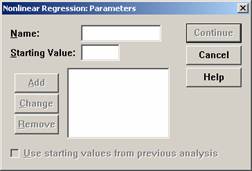
图5-2 设置参数初始值
“Name”框用于输入参数名称。
“Starting”框用于输入参数的初始值。
输入完参数名和初始值后,单击“Add”按钮,则定义的变量及其初始值将显示在下方的参数框中。需要修改已经定义的参数变量,先用将其选中,然后在“Name”和“Starting”栏里进行修改,完成后点击“Change”按钮确认修改。要删除已经定义的参数变量,先用将其选中,然后点击“Bemove”按钮删除。
在本例逻辑斯蒂模型中估计的参数有“K”、“a”和“b”三个参数变量。设置初始值为:K=0.1;a=3;b=0.1。
参数的初始值可根据给定模型中参数定义范围情况而定。输入后的“Nonlinear”对话窗口如下图。
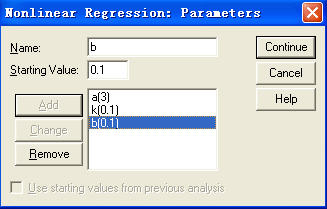
图5-3 设置参数初始值后的对话框
完成后点击“Continue”按钮。
5)输入方程式
在“Model Expression”框中输入需要拟合的方程式,在该方程中包含自变量、参数变量和常数等。自变量和参数变量可以从左边的列表框和“Parameters”框里选入。
方程中的函数可以从“Function”框里选入;运算符号和常数可以用鼠标从窗口“数字符号”显示区中点击输入。
本例输入的逻辑斯蒂模型是: K/(1+EXP(a-b*t))。输入后的窗口显示如下图。
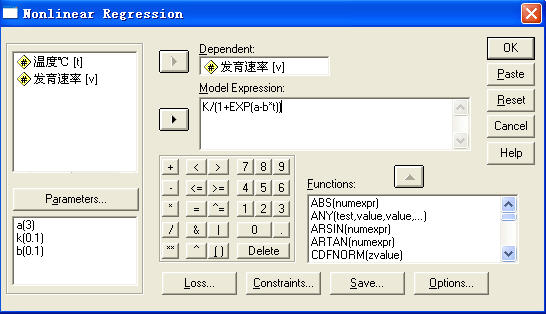
图5-4 设置后的非线性回归对话窗口
6) 迭代条件
在主对话框中单击“Loss”按钮,将打开如图5-5所示的对话框。

图5-5 Loss 对话框
![]() Sum of squared residuals”项,残差平方和最小值,系统默认。本例选该项。
Sum of squared residuals”项,残差平方和最小值,系统默认。本例选该项。
![]() “User-defined loss function”自定义选项。设置其他统计量为迭代条件,在下边输入框中输入相应的统计
“User-defined loss function”自定义选项。设置其他统计量为迭代条件,在下边输入框中输入相应的统计
量的表达式,称为损失函数。在左上角的变量列表框中,“RESID”代表所选变量的残差;“PRED_”代表预测
值。可以从左下角框中选择已定义的参数进入损失函。
7)参数取值范围
在主对话框中单击“Constraints”按钮,将打开如图5-6所示的对话框。在该对话框中设置回归方程中参数的取值范围。
选中“Define parameter constraint”项,即可对选定的参数变量设置取值范围。参数的取值范围,用不等式“=,<=,>=”来定义。
例如,在本例逻辑斯蒂模型中K参数应该小于1。应该定义如下:k<=0.9999
定义后会提示:是否复制现有的变量名,回答“确定”。
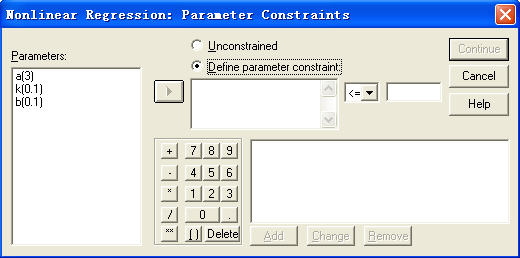
图5-6 参数取值范围对话框
8) 保存分析数据
在主对话框中单击“Save”按钮将打开如图5-7所示的对话框,选择要保存到数据文件中的统计量。
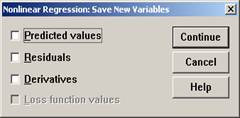
图 5-7 Save对话框
其中各项分别为:
![]() “Predicted values”因变量的预测值。
“Predicted values”因变量的预测值。
![]() “Residuals”因变量的残差。
“Residuals”因变量的残差。
![]() “Derivatives”派生数。
“Derivatives”派生数。
![]() “Loss function values”损失函数值。
“Loss function values”损失函数值。
9) 迭代方法
主对话框中单击“Options”按钮,将打开如图5-8所示的对话框。

图5-8 迭代方法对话框
“Bootstrap estimates of standard error”项,将采用样本重复法计算标准误。样本重复法需要顺序二次规划算法的支持。当选中该项时,SPSS将自动选中“Sequential quadratic Programming”项。
“Estimation Method”框中列出了参数的两种估计方法:
“Sequential Quadratic Programming”项为顺序二次规划算法。该方法要求输入的参数为:
“Maximum”最大迭代步数。
“Step Iimit”最大步长。
“Optimality”目标函数的迭代误差限。
“Function”函数精度,应比目标函数的迭代误差限小。
“Infinite step”当一次迭代中参数值的变化大于设置值,则迭代停止。“Levenberg-Marquardt”项,采用麦夸尔迭代法),系统缺省设置。该法要求输入的参数为:
|
“Maximum iterations”最大迭代步数。 |
本例选“Levenberg-Marquardt”项,最大迭代步数100,残差平方和的变化比例小于1E-8,参数的变化比例小于1E-8。
10)提交执行
所有的设置完成后,在主对话框中点击“OK”按钮提交所有设置,SPSS执行过程后输出结果显示在输出窗口中。
11) 结果分析
结果:
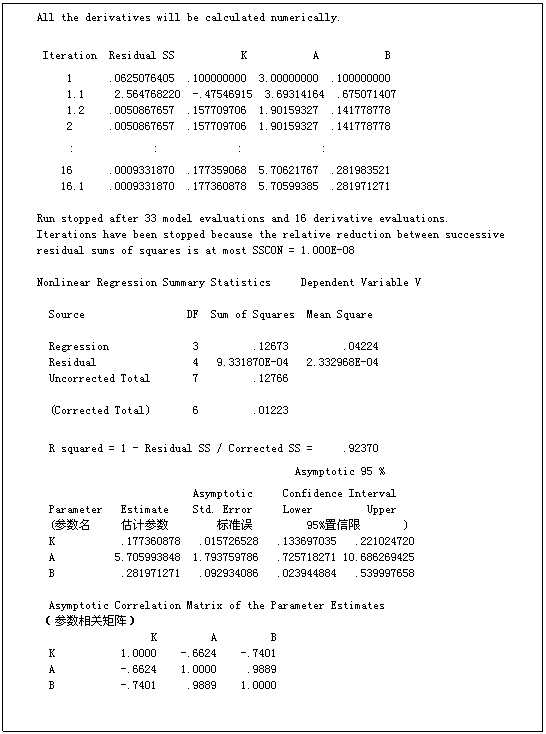
根据以上输出结果得到K的参数估计值是0.177360878;a的参数估计值是5.705993848;b的参数估计值是0.281971271。其拟合的逻辑斯蒂发育速率模型为:
![]()
残差平方和(Q)为0.0009331870;拟合优度系数(R2)为0.92370。
本网站所有内容来源注明为“梅斯医学”或“MedSci原创”的文字、图片和音视频资料,版权均属于梅斯医学所有。非经授权,任何媒体、网站或个人不得转载,授权转载时须注明来源为“梅斯医学”。其它来源的文章系转载文章,或“梅斯号”自媒体发布的文章,仅系出于传递更多信息之目的,本站仅负责审核内容合规,其内容不代表本站立场,本站不负责内容的准确性和版权。如果存在侵权、或不希望被转载的媒体或个人可与我们联系,我们将立即进行删除处理。
在此留言








同样的方法,运行出来,迭代次数为0,请问是什么原因啊?
63
对我帮助很大,谢谢
100
#回归分析#
26
#线性回归#
27